Are you a Quiet Speculation member?
If not, now is a perfect time to join up! Our powerful tools, breaking-news analysis, and exclusive Discord channel will make sure you stay up to date and ahead of the curve.
I fully intended to play in SCG Milwaukee last weekend. I'd been practicing and preparing for weeks, tuned my deck, and even made the travel arrangements. Then the two great powers of plan ruination, unexpected work and bad weather, derailed my plans. However, I'm not one to let all that work go to waste. Instead of the tournament report that I had planned, I will share what I learned about the metagame and where it led me. Hopefully it will help those of you going to GP Hartford this weekend.
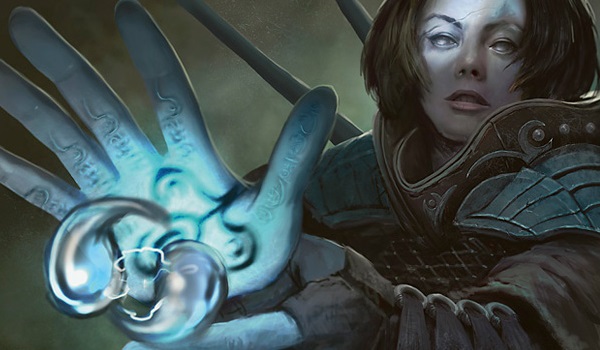
Accumulating Data
I spend a lot of time studying the metagame before large constructed events. Most players do, but that usually involves looking at aggregate data: either overall metagame standings or the MTGO League 5-0 results. This is a great way to determine what is winning and therefore what is good in the meta, but that's not what I'm after. Rather, I want to know what players are actually playing. In my experience, a GP or Open Day 1 looks wildly different from the aggregate data. In fact, it isn't until late on Day 2 when the population begins to reflect the "real" metagame.
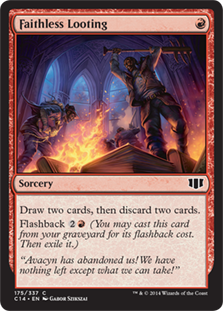 Simply asking around about what local players were on wasn't enough. Local metagames can be very warped or inbred. To combat this, I added in what gets played on MTGO. Doing so used to be reasonably easy; we could just watch the replays. Checking the first few minutes of as many games as possible revealed enough about popular decks to form a reasonably good picture of the "got played" metagame.
Simply asking around about what local players were on wasn't enough. Local metagames can be very warped or inbred. To combat this, I added in what gets played on MTGO. Doing so used to be reasonably easy; we could just watch the replays. Checking the first few minutes of as many games as possible revealed enough about popular decks to form a reasonably good picture of the "got played" metagame.
This technique isn't possible anymore, but I've developed a work around: use streamers. I don't watch the whole stream or even pay attention to what the streamer is actually playing. The first is time-prohibitive, and many streamers play the flavor of the week or favor weird or bad decks. Instead, I skip through to see what their opponents are playing. Each individual stream isn't particularly informative, but put together, pattern and trends emerge.
What follows is what I observed.
The Format Has Slowed Down
I don't have hard data on this claim, but about two-thirds of decks I've played against and half the decks I saw while studying could not reliably goldfish kill before turn six. Most of the blue decks couldn't do that even under ideal conditions. This is more because of an increase in midrange than of one in control. Jund seemed to be the most popular deck, but Mardu Pyromancer and GR Ponza were also common. Eldrazi and Gx Tron were also frequent choices.
Bloodbraid is Everywhere
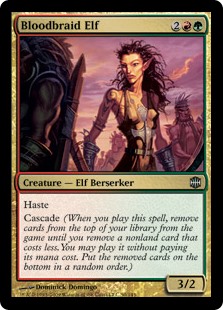 My theory is that Bloodbraid Elf is responsible for the slowdown. It's powerful and flashy, and lots of players want to play that kind of game. However, I have yet to see any kind of aggressive deck featuring Bloodbraid succeed. Decks that are capable of a turn-four or earlier goldfish can't risk hands clogged by four-drops. RG Eldrazi is the closest I've seen, and it's more of a Stompy-style deck than true aggro.
My theory is that Bloodbraid Elf is responsible for the slowdown. It's powerful and flashy, and lots of players want to play that kind of game. However, I have yet to see any kind of aggressive deck featuring Bloodbraid succeed. Decks that are capable of a turn-four or earlier goldfish can't risk hands clogged by four-drops. RG Eldrazi is the closest I've seen, and it's more of a Stompy-style deck than true aggro.
A proven way to use Bloodbraid's power is to slow the game down by interacting, and then drown opponents in tempo and card advantage. Faced with additional interaction, faster goldfish decks are suffering, and pilots are switching to decks that don't lose to interaction. So it's no wonder Jund was the deck I saw the most, with Ponza and/or RG Eldrazi making at least one appearance per league and multiple at each paper event I played in.
So Much Discard
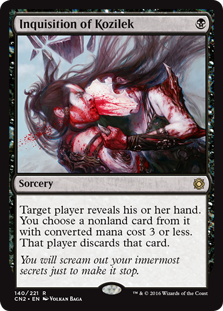 The primary interactive strategy was targeted discard. That's hardly news, considering what I've said about Jund, but there were other culprits too. About three-fourths of the midrange and control decks were black-based, with the rest being either Jeskai or UW Control. This included more Abzan and Mardu Pyromancer than I expected. In fact, about two-thirds of the decks in total featured Inquisition of Kozilek and Thoughtseize, including rogue aggro and combo decks.
The primary interactive strategy was targeted discard. That's hardly news, considering what I've said about Jund, but there were other culprits too. About three-fourths of the midrange and control decks were black-based, with the rest being either Jeskai or UW Control. This included more Abzan and Mardu Pyromancer than I expected. In fact, about two-thirds of the decks in total featured Inquisition of Kozilek and Thoughtseize, including rogue aggro and combo decks.
The power of picking apart an opponent's hand is common knowledge. I knew that black strategies were popular, but the sheer number of observed games involving a turn one discard spell was unexpected. Many decks also ran Collective Brutality and Liliana of the Veil. Having cards in hand after turn four appears to be a luxury in Modern right now.
The Grind is Real
As a result of the slowdown and the discard, most matches turned into topdeck grindfests. The usual response when the format encourages grinding is to go hard aggro, and I wasn't seeing that adjustment. Humans was popular, and I'll get to that next, but there weren't many other decks that specifically avoided grinding. Most players accepted that the 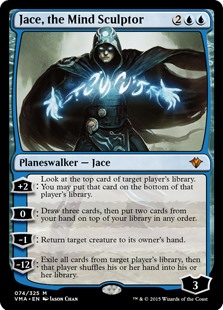 game would come down to at battle waged by impactful libraries and played along.
game would come down to at battle waged by impactful libraries and played along.
Interestingly, this really boosted the value of Jace, the Mind Sculptor. When you just slam Jace down on-curve, a lot of the time he has no measurable impact. The best that would happen was the threat of Jace drew Thoughtseize's gaze away from more important cards.
However, in most midrange matches, towards the mid-game, the board was usually clear or at least stalled until someone hit a string of lands and lost. Jace always broke parity, whether by bouncing a critical threat or just drawing extra cards. Whoever had Jace the longest won the control mirrors. The advantage Jace generates in a stalled game will eventually overpower the opponent.
It's Just Humans
Of the remaining non-midrange decks, about half were Humans. This is odd to me. Humans is a known good deck and is fairly cheap to build, so it's easy for players to gravitate towards. However, in my experience, the deck is a massive dog to Jeskai and Jund. There are too many different answers for Meddling Mage and Kitesail Freebooter to stop, and after the initial wave is exhausted, it's hard to rebuild. Champion of the Parish is amazing turn one, but really weak turn six.
The deck is redundant enough that discard doesn't hurt it much, and fast enough to win before the grind really begins, but if struggles to regain its footing after stumbling. Given how many decks were out there that tend to make Humans stumble, its prevalence was surprising. I expected Bogles to be more popular for that reason, but saw at most three.
Lots of Fragile Combo
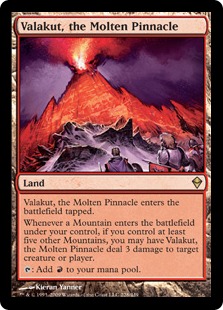 Perhaps it's all of the Humans running around, but I never saw Storm either online or in person. That doesn't mean that combo was non-existent, but all the discard made critical-mass-of-spells-combos unattractive. Instead, combo players were going for the play-out-stuff-then-wait-for-the-critical-card combo decks like Ironworks Combo, RG Valakut, and Amulet Titan.
Perhaps it's all of the Humans running around, but I never saw Storm either online or in person. That doesn't mean that combo was non-existent, but all the discard made critical-mass-of-spells-combos unattractive. Instead, combo players were going for the play-out-stuff-then-wait-for-the-critical-card combo decks like Ironworks Combo, RG Valakut, and Amulet Titan.
This trend is in line with earlier observations. Power-card-style combo decks are far better-positioned in discard-heavy metagames. Valakut is the best one, as lands can't be hit by Thoughtseize. Seize can take Scapeshift and Primeval Titan, but there's nothing to stop players from just dropping Valakut, the Molten Pinnacle. Similarly, most of Ironwork's cards are redundant, and draw into to the piece that got discarded. Lastly, Amulet has Tolaria West into Summoner's Pact to combo through discard.
The conclusion I reached was that Modern has become more warped around discard than ever.
Hollow One is Dredge, But Worse (For Everyone)
I saw a lot of Goblin Lores during preparation, and played against several, and realized BR Hollow One is both more frustrating to play against and less threatening than was Dredge with Golgari Grave-Troll. The BR Hollow One decks have a lot in common with Dredge. They play Magic uniquely, relying on recursive creatures, and are weak to graveyard hate. They are also capable of blistering starts that are extremely difficult for many decks to answer. In fact, Hollow One's best starts are far harder to beat than Dredge's.
At its most 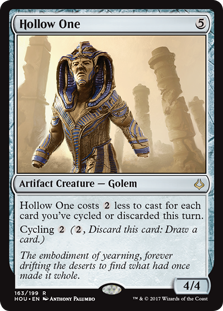 abusive, Dredge deployed multiple Prized Amalgams, Narcomoebas, and Bloodghasts on turn two. Hollow One can theoretically drop four Hollow Ones on turn one. Any sweeper or removal can save you against that Dredge draw. Only multiple Path to Exiles will keep you from dying to those Hollow Ones.
abusive, Dredge deployed multiple Prized Amalgams, Narcomoebas, and Bloodghasts on turn two. Hollow One can theoretically drop four Hollow Ones on turn one. Any sweeper or removal can save you against that Dredge draw. Only multiple Path to Exiles will keep you from dying to those Hollow Ones.
However, Hollow One is its own worst enemy. My favorite moment watching MTGO streams and videos was when a Hollow One player's turn one Burning Inquiry gave his opponent two free Wilt-Leaf Lieges to his lone Hollow One. Inquiry is a random bullet, and it hits its owner about as often as it hits opponents.
Bloodghast and Flamewake Phoenix are annoying, but the heart of the deck is Gurmag Angler and Hollow One. If those get randomly discarded, the deck falls apart: Phoenix doesn't come back on its own; Bloodghast isn't much of a threat; and Flameblade Adept dies to everything. Dredge doesn't have a fail state, except for graveyard hate—so long as it can dredge, it will chug along. Hollow One has a higher variance ceiling and a lower trough.
Anger of the Gods is Great
Watching decks fail to permanently answer Bloodghast actually made me wonder why Anger of the Gods isn't seeing more play. I saw mainly saw Sweltering Suns in the red sweeper role, and it seems worse to me. There is just so much utility in exiling creatures. And not only against creatures that refuse to die. Against Jund, exiling creatures means they provide no Tarmogoyf or Scavenging Ooze value.
Cycling makes Suns an easier maindeck choice, but I didn't see Anger in sideboards either. There are few good ways to deal with Hollow One's best draws, but Anger goes most of the way towards beating the average draws. I'd make that switch before complaining about the deck.
How I Responded
Based on my observations, I expected lots of discard, grinding, and Humans. There would be blue control decks and combo lurking in enough numbers to be relevant, but for the most part, I should expect black decks. I therefore wanted a deck with lots of card advantage that couldn't just be picked apart. It also needed to be able to answer or keep up with Humans.
At first, I considered a Jeskai Control deck, but didn't have a list that I liked. They were all a little too compromised and untuned for my taste. I was also skeptical of my ability to play control at a high level for eight rounds. Fortunately, I had another deck that I knew could grind well and had a decent Humans matchup. With a tweak, it also proved strong against discard.
Death and Taxes
To hedge against discard, I took a page from Bogles' playbook and maindecked Leyline of Sanctity. During testing it worked out very well, turning Jund from a bad matchup to an even grindfest. I have a lot of two-for-ones built in to the deck's fabric, and it paid to protect them from getting one-for-oned. Leyline was also incidentally impressive against Burn, 8-Rack, and other combo decks.
Going Forward
Lots of of decks struggle against Leyline, and I'll be watching this weekend to see if other players land on it as a way to beat discard. For those of you heading to Hartford, I advise having a plan of some sort for Inquisition of Kozilek. Good luck, and may you topdeck well!





I have been playing maindeck leyline of sanctity ever since hour of devestation came out and it is consistently one of the best cards my deck plays.
Then you were ahead of the curve. It definitely over performed for me in testing, not sure how it would have worked out in reality.
Somewhat off topic question I know… I’ve been reading your articles for some time and I really appreciate these meta-game articles. However, as a single father of a couple young kids, I don’t have time for MTGO and really only sporadically escape for FNM or a 5k. I have a month during modern PPTQ where I grind every Saturday and Sunday while the kids are gone. Last summer I went with UW, managed some top 8’s but no better. I need the rest of this spring to really master a deck but am looking for something that has game against he field ala old Jund despite subtle meta-shifts that occur. Decks I could play include: AV Temur Moon (front runner), UW Control, Skred (Anger being good), or something linear like Burn/Bogles.
If you have any feedback about any these decks as they stand in a world of Hollow One, Humans, and other top decks, I’d appreciate your feedback. Sorry to be off-topic.
Not a problem. Based on what I’ve seen and given your options, Bolt-Snap-Bolt decks are very well positioned. I’ve found them to be very good against Humans, Affinity, and are at least even against the 8+ discard decks. If you’re worried about Hollow One then you need Path to Exile and UW is a fine option because it is also good against the aforementioned decks. Bogles is not well positioned overall, but it’s also the kind of deck that doesn’t need to be. It will just spike a tournament periodically, and if you have limited time and resources that may be a far better strategy.